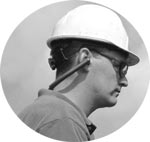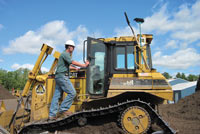
Cutting Noise Down to Size
An innovative hearing protection device reduced noise for Terry Tree Service LLC's employees and subcontractors, who work in large disaster cleanup zones.
| Frequency Chart |
| Frequency (Hz) |
125 250 500 1000 2000 3150 4000 6300 8000 NRR |
| Mean Attenuation (dB) |
32.5 34.7 31.4 33 33.4 39.4 37.6 37.2 37 26 |
| Standard Deviation (dB) |
4.3 4 3.2 2.5 2.6 4.3 4 4.7 3.7 — |
Tim Pope was immediately intrigued when he first saw the hearing protection device because it was unlike any ear plug or muff he'd ever seen. Pope, vice president and owner of rapidly growing tree service company Terry Tree Service, LLC, then saw the company's claims for the product — comfortable, totally passive hearing protection that allows conversation during use — and just had to try them.
"Being in an industry where hearing protection is so important, being able to get protection and still have crew members able to communicate effectively is the perfect scenario," he recalled. Formed in 1995 and based in Rochester, N.Y., Terry Tree Service is a national contractor that specializes in residential and commercial land clearing, storm disaster recovery, and wood resource recycling. With a current employee base of 58, including four full-time arborists, the company maintains a network of several hundred subcontractors across the United States. It has assisted federal, state, and local governments in many disaster relief efforts for hurricanes, tornadoes, floods, snow, and ice storms.
Able to mobilize hundreds of dump trucks and trailers, bobcats, self-loading grapple trucks, front end loaders, and grinders within 48 hours, the company can put more than 100 crews and hundreds of workers in the field on demand. In 2005, for example, Terry Tree had crews working simultaneously in Mobile, Ala., and New Orleans for Hurricane Katrina; in Lafayette, La., for Hurricane Rita; and in West Palm Beach, Fla., for Hurricane Wilma. In New Orleans, the company's debris removal area covered some eight square miles and included more than 15,000 homes.
Safety has always been a top priority at Terry Tree, a fact reflected in its very low incident rate and numerous safety awards. "Our mod rate for worker's comp places us in the same risk category as stenographers," noted General Manager and Safety Director John Schwelm. His strong emphasis on safety not only has earned the company financial benefits in reduced insurance premiums, but also is considered by management as a key factor in the company's growth and its ability to attract and retain both employees and subcontractors.
Hearing safety is no exception, and for good reason. According to NIOSH estimates, a typical bulldozer generates about 105 dB of noise, a grinder 108 dB, and a chain saw 110 dB. Because the decibel scale is logarithmic, sound energy doubles for every 3 dB increase in noise levels, and permissible exposure limits decrease accordingly. At 91 dB, for example, the permissible exposure limit is down to 2 hours, and at 109 dB — right between grinder and chain saw levels — permissible exposure is two minutes. In short, it doesn't take very long at all for noise from a chain saw to damage unprotected hearing.
Like construction, the tree industry is covered by OSHA's omnibus "Safety and Health Regulations for Construction" standards (CFR 1926). Unlike its industrial counterpart, however, this regulation does not require dosimetry, audiometry, training, or recordkeeping on the part of employers. It simply identifies hazardous noise levels (CFR 1926.52) and states that hearing protectors "shall be provided and used." Terry Tree has taken CFR 1926 quite literally and, according to Safety Director Schwelm, mandates that "all exposed workers — our own as well as subcontractors — will wear adequate hearing protection, without exception."
Putting Protection to the Test
But that doesn't mean it's either easy or pleasant to wear hearing protection in a work environment that is oft en hot and dirty, where the air is often filled with flying sawdust. Ear muffs can be warm in the winter, but in hot weather they can be extremely sweaty and irritating. Rolling down ear plugs for insertion with fingers that may have been exposed to a disaster recovery site can be positively hazardous. And in a work environment where falling limbs and branches are the norm, good communication is essential for safety, a fact that oft en mitigates against good hearing protection.
So while Terry Tree was not in the market for a new type of hearing protector, these use factors gave Tim Pope another reason to try the new devices: They neither were inserted into the ear canals like ear plugs nor covered the ears like ear muffs. They simply sat at the entrance to the ear canal: light, comfortable, and with very little pressure.

According to NIOSH estimates, a typical bulldozer generates about 105 dB of noise, a grinder 108 dB, and a chain saw 110 dB. Because the decibel scale is logarithmic, sound energy doubles for every 3 dB increase in noise levels, and permissible exposure limits decrease accordingly. At 91 dB, for example, the permissible exposure limit is down to 2 hours, and at 109 dB — right between grinder and chain saw levels — permissible exposure is two minutes. In short, it doesn’t take very long at all for noise from a chain saw to damage unprotected hearing.
The devices are indeed a new approach to hearing protection. The products are based on technology invented by Dr. Jozef John Zwislocki, one of the leading pioneers of modern audiology. Now 87 years old, Zwislocki is Distinguished Professor of Neuroscience Emeritus at Syracuse University, where he founded the Bioacoustics Lab in 1957. Among his many achievements, he is the inventor of the "Zwislocki Coupler," which has been accepted as a national standard for hearing aid earphones. In 1985, he became the first recipient of the Von Békésy Medal in Physiological Acoustics from the Acoustical Society of America "for landmark contributions to our knowledge of the hydromechanical, neurophysiological, and perceptual mechanisms of the auditory system" — it was one of only three ever awarded.
Rather than block or filter sound, the sound-attenuating technology in the new device channels excessive noise into small chambers located above the earpieces, where it is refracted and cancelled. The device is totally passive and uses no electronics or batteries. The units weigh less than 2 ounces and are fully compatible with hard hats and other PPE. They also can be hung around the neck when not in use or folded up and put in a breast pocket.
Most important, however, is the way the technology blocks harmful sound but allows speech to be heard in noisy environments with virtually no distortion. In independent tests conducted to ANSI S3.19-1974, the 26 NRR unit achieved a mean attenuation average of 32.8 dB in the low 125 Hz to 500 Hz frequency range. These low-frequency noises are the ones that typically mask speech communication. In the mid-range, between 500 Hz and 2000 Hz (the frequency of most speech), attenuation characteristics were flat, averaging around 33 dB, meaning sound is reduced evenly. Th is lessens distortion and maintains high speech intelligibility. Above 2000 Hz — the most damaging frequencies to the human ear — the mean attenuation average rose appreciably to 37.8, making the ZEM units even more effective hearing protectors.
"We tried them immediately," said Pope, "and the guys just loved them. They're nice and easy to wear, they're not cumbersome, I don't get a pressure headache . . . . And you can literally carry on a conversation while you're wearing them, even in a noisy work environment. I even use them for shooting."
But perhaps the biggest surprise came when Pope and his partners began analyzing costs. At about half the cost of a typical industrial ear muff, and with only small ear tips to replace instead of entire ear cups, it was expected the units would generate savings compared to muffs. But when they factored in the product's longevity and the number of plugs required during any given month, it became clear they would be more cost effective in that regard, as well. "We're still integrating the SensGard units into our workforce on a replacement basis," said Pope, "so we have not yet been able to do a formal cost analysis. But we have seen the results of a study done by a manufacturing company in Syracuse, N.Y., with hundreds of employees. Based on the number of ear plugs they bought, they found that they saved thousands of dollars over the course of a year by just using the . . . units and periodically changing the tips."
Terry Tree Service is justifiably proud of its growing reputation as a leader in the tree industry. With the current emphasis on expanding the U.S. power grid, it has plans to continue its growth trajectory and is expanding in other areas. Recently, the company started a safety products distribution arm, TMT Safety Products, with these hearing protection devices among its flagship products.
This article originally appeared in the October 2009 issue of Occupational Health & Safety.